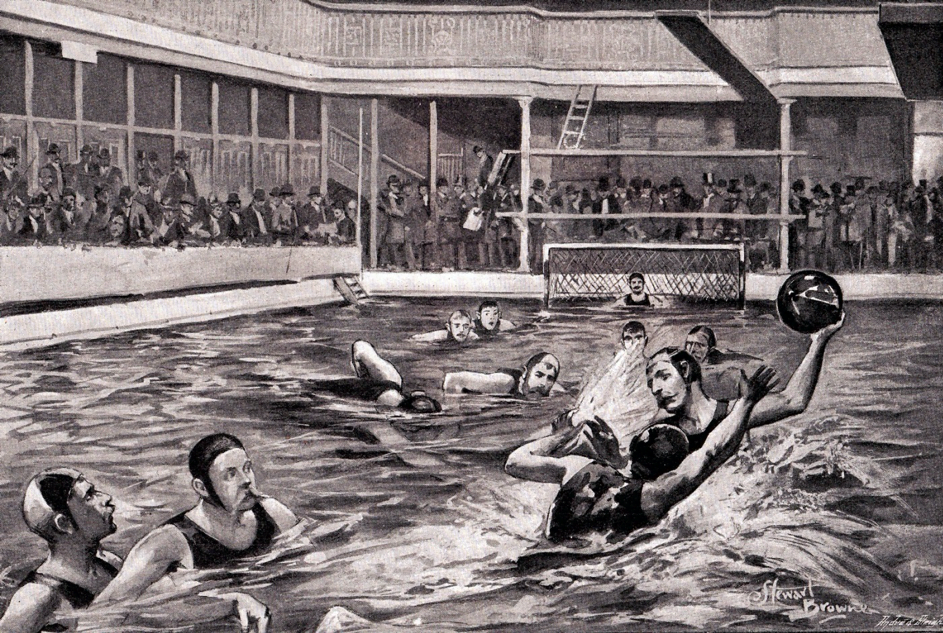Your Cart is Empty

The Evolution of the Water Polo Ball
February 06, 2023 4 min read
The modern game originated in the late 19th century as a form of rugby football, played in rivers in England and Scotland, with a small 3 to 4 inch ball constructed of rubber imported from colonial plantations in India. This "water rugby" came to be called "water polo" based on the English pronunciation of the Balti word for ball, pulu. The original ball soon gave way to a football (soccer ball), which allowed for passing and swimming above water with the ball.
Original water polo balls were made from a pig’s stomach. In fact, one of the earliest water polo balls was the Bladder Ball. This ball was made of leather and filled with air to provide buoyancy in the water. The Bladder Ball was relatively heavy, weighing in at around 14 ounces, making it difficult for players to handle in the water. Despite these limitations, the Bladder Ball was widely used in early water polo competitions and became a staple of the sport.
However, the leather football absorbed water and became extremely heavy, slippery and out-of-control when wet. In 1936, James R. ("Jimmy") Smith, California water polo coach and author of several books on water polo mechanics, developed a ball made with an inflatable bladder and a rubber fabric cover, which improved performance.[6] The new ball was red, very different from the modern yellow color.
The first official water polo match was played in the Crystal Palace Plunge in London. When the Trudgeon stroke was established, by 1880 in Scotland, water polo became a faster sport and the way of scoring a goal changed to throwing the ball into a cage that was 10ft wide and 3ft deep. The ball changed to a leather football and players could now only handle the ball using one hand and only be tackled once in possession of the ball.
The second nation after Britain to actively participate in water polo games was America. Their games were often more violent as water wrestling and fights captured the attention of crowds more than in-play action.
In the early 1900s, new materials began to be used to make water polo balls. One of the first was the "Inflatable Ball," invented by Richard Paton in 1901. This ball was made of rubber and filled with air, making it much lighter and more buoyant than the Bladder Ball. The Inflatable Ball weighed in at around 10 ounces, making it easier for players to handle in the water. Despite its lighter weight, however, the Inflatable Ball was still relatively heavy compared to modern water polo balls.
In 1922, first full molded, all-rubber inflatable ball was invented, then inn 1936, James R. Smith, in collaboration with AMF Voit, invented a rubber ball with a cotton bladder. At this time, the color of the ball changed from red to yellow. Folklore says that the most available rubber material used for the new balls was made from yellow life vests, but most agree that it was changed because yellow was more visible. In the 1950s and 1960s the first rubber-bodied water polo ball which was adopted as the official ball for college, international, and Olympic competitions.
Today, most water polo balls are made from a combination of materials, including rubber, foam, and synthetic materials. The weight of these balls has continued to decrease over time, with modern water polo balls weighing in at around 5 ounces. This lighter weight allows players to handle the ball more easily in the water and to make more precise passes and shots.
In addition to lighter weight, modern water polo balls also feature a range of other design elements. For example, many balls now feature a textured surface that provides better grip in the water. Other balls feature brightly colored designs that make them more visible in the pool, while still others are made from materials that are more resistant to damage from the chlorine in pool water.
The evolution of the water polo ball has been driven by a desire to make the sport more accessible and enjoyable for players. From the heavy leather Bladder Ball of the 19th century to the lightweight, high-tech balls of today, water polo balls have come a long way. Whether you're a beginner or a seasoned pro, having the right ball can make all the difference in your game.
KAP7 water polo balls are the most trusted balls in the sport. Our balls are made from Formula 1 tier rubber giving them the longest lasting grip and making them the most durable balls on the market . They have even been pressure tested by having an elephant jump on them, watch the video here.
In the first half of 2005, FINA allowed a change to the standard water polo ball used in official games. This change permitted a colored middle stripe (blue, green, red, black, or yellow) with the normal yellow stripes flanking the colored. KAP7 the first ball to offer customizable colors and patterns which are now common place. KAP7 has a large offering of water polo balls, shop now.
Leave a comment
Comments will be approved before showing up.

Signup for our newsletter
Be the first to get new products, training videos, and updates.

